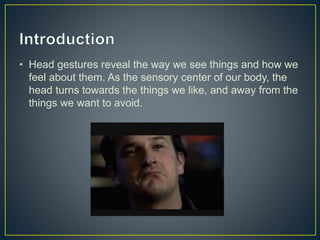Nods : Signal and Meaning
- 1. Summary :- • Introduction • Head Thrust and head Retreat • Head Tilt • Rhythm, Length and Gaze • Head Beckoning • Speed and Rhythm
- 2. • Head gestures reveal the way we see things and how we feel about them. As the sensory center of our body, the head turns towards the things we like, and away from the things we want to avoid.
- 3. • Truth is, it's quite instinctive to "get it" when it comes to the meaning of head gestures. We know that a nod means a 'yes' and shaking the head means a 'no' (most of us anyway). • We also learned to recognize many other more subtle movements subconsciously, meaning we get a certain feedback from them but often if we were asked why is that so - we couldn't say.
- 4. • Head Thrust - When we're extremely angry we thrust our head forward, ready for battle like a predator locked on his pray. We neglect our self defense and focus on the attack, some people won't hesitate to use their head as a weapon and head-butt their opponent. • Head Retreat - Just think of a turtle retreating back into the safety of his house. We do that when we're afraid and defensive, obviously, but also when we feel negatively towards what's happening - we back away from what we don't like.
- 5. • The kind of interest and attention can be diverse and depends upon the context: • An interviewer who tilts his head and nods signals the interviewee to continue speaking, he finds his message important. • It can be a sympathetic gesture of interest: "are you ok? You don't look so well...“ • A head tilt up and to the side reveals surprise or disbelief: "wow...really?"
- 6. • Slow and lengthy nods usually show agreement and understanding, they're not urging you to finish talking. "Take your time I'm listening“ • Small nods combined with a smile is an encouraging and bonding signal. • A fast rapid nod, especially if the listener is touching his ear or rubs his face, show impatience and urge you to move on or let them do the talking. "yeah I got it, let's move on"
- 7. • It's a quick dip of the head downwards or a little toss of the head backwards, usually to signal recognition. • It's a nonverbal way of greetings when shaking hands seems inappropriate or uncomfortable or a prelude to such physical contact.
- 8. • A fast and rhythmic head shaking definitely says - “no, I disagree, this is not true.” • A slow and irregular turning of the head usually signals misunderstanding. Something didn't get through quite right. • Slow and rhythmic head shaking can also signal disbelief. We cannot accept what we just heard.
- 9. • Name – Priyansh J. Thakar • Batch – CE 2 : A • ID. No. – 16BECEG082








